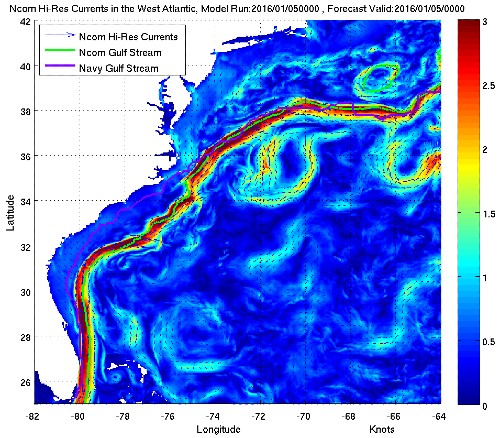The Atlantic Conveyer, otherwise the Gulf Stream − that great flow of surface water pouring northwards that overturns in the Arctic and heads south again at great depth − is now weaker than at any point in the last 1,000 years, European scientists report.
And in a second, separate but related study, researchers have found that the Beaufort Sea, in the Arctic, has gained two-fifths more fresh water in the last 20 years: water that could flow into the Atlantic to affect the Conveyor, and with it, climatic conditions.
Scientists call it the Atlantic Meridional Overturning Circulation or just AMOC. Europeans know it as the Gulf Stream: the current that conveys tropic warmth to their coasts and keeps Britain and Western Europe at a temperature several degrees higher than latitude alone might dictate.
And for years, oceanographers and climate scientists have been observing a slowing of the flow, by as much as 15%. But direct measurement of the great current began only relatively recently in 2004: researchers needed to know whether the slowdown was part of a natural cycle, or a consequence of climate change driven by global heating.
Now they know a little more. European researchers report in Nature Geoscience that they looked for evidence of ocean circulation shifts in what they call “proxy evidence”: the story of climate change told by tree growth rings, ice cores, ocean sediments, corals and historical records, including naval logbooks.
The combined evidence of temperature patterns, the sizes of particles of ocean floor sediment and the salinity and density of sub-surface water helps build up a picture of the Atlantic current for the last 1,600 years.
The verdict? Up to the 19th century, ocean currents were stable. The flow is now more sluggish than at any time in the last millennium.
This is roughly what climate models have predicted: the warm salty water moves north, cools, becomes more dense, sinks to the deep and flows back south. But the Arctic has begun to warm, Greenland to melt, and the flow of fresh water into the northern seas to intensify.
Since the flow is driven by the difference in temperatures, any change in the regional thermometer will play back into the rate of flow. And any extra arrival of fresh water could further slow the overturning circulation.
“The Gulf Stream system works like a giant conveyor belt, carrying warm surface water from the equator up north, and sending cold, low-salinity deep water back down south. It moves nearly 20 million cubic meters of water per second, almost a hundred times the Amazon flow,” said Stefan Rahmstorf, of the Potsdam Institute for Climate Impact Research, in Germany, one of the authors.
“For the first time, we have combined a range of previous studies and found they provide a consistent picture of the AMOC evolution over the past 1600 years. The study results suggest that it has been relatively stable until the late 19th century.
“With the end of the Little Ice Age in about 1850, the ocean currents began to decline, with a second, more drastic decline following since the mid-20th century.”
Outcome awaited
The change could have ominous consequences for European weather systems: it could also deliver more intense coastal flooding to the US eastern seaboard. If the current continues to weaken, the consequences could be catastrophic.
Which is why a new study in Nature Communications matters so much. US researchers tracked the flow of fresh water from the Beaufort Sea − melt water from glaciers, rivers and disappearing Arctic sea ice − through the Canadian Archipelago and into the Labrador Sea.
Arctic water is fresher than Atlantic water, and richer in nutrients. But this extra volume, measured at a total of 23,300 cubic kilometres, could also affect the rate of flow of the overturning circulation. That is because relatively fresh water is less dense than saline water, and tends to float on top.
Quite what role it could play is uncertain: the message is that, sooner or later, it will escape into the North Atlantic. Then the world will find out.
“People have already spent a lot of time studying why the Beaufort Sea fresh water has gotten so high in the past few decades,” said Jiaxu Zhang, of the Los Alamos National Laboratory, first author. “But they rarely care where the freshwater goes, and we think that’s a much more important problem.” − Climate News Network
Author
Tim Radford, a founding editor of Climate News Network, worked for The Guardian for 32 years, for most of that time as science editor. He has been covering climate change since 1988.
![]() Don't forget to feed the birds. Donate here
Don't forget to feed the birds. Donate here







